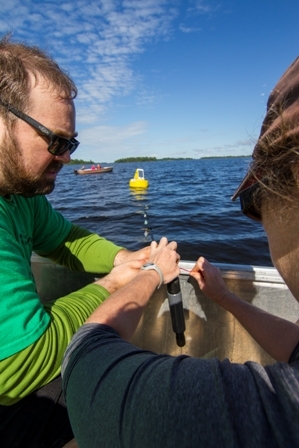Researchers helping understand Lake Nipissing

In the face of harmful algae blooms popping up on Lake Nipissing, students and researchers at Nipissing University are working to better understand what is happening in the lake.
The Lake Nipissing Bays project involves students and faculty from the university’s Geography department, Computer Science and Mathematics departments and Watershed Analysis Centre collecting and interpreting key data for a greater understanding of water quality conditions in different parts of the lake, including bays of interest for drinking water quality, recreation and fish habitat.
The project began in 2013, when researchers in the Geography department began intensive monitoring using a lake buoy on loan from the Dorset Environmental Science Centre to suspend instrumentation in the water column. The buoy was anchored in the deepest spot in Callander Bay, one of the three sheltered bays in the lake that experience harmful algae blooms. The instruments collected hourly measurements of water temperature and light every meter through the water column, and oxygen levels in the deepest four meters.
Earlier this year, the team earned a $50,000 grant from the Ontario Ministry of Environment to expand the project, and over the last several months, lake buoys have been anchored in Callander Bay, Cache Bay and the West Arm of Lake Nipissing. The new buoys are recording weather conditions (wind speed, direction, and relative humidity) and additional measurements of water quality, including pH, conductivity, turbidity and total algae at a depth of one meter.
The public can view provisional data from the three lake buoys and more details on the project and the people at http://wac.nipissingu.ca.
“In order to protect the longterm health of Lake Nipissing, we need to understand exactly what is happening in it and how a number of factors could be impacting water quality” said Dr. April James, Canada Research Chair – Watershed Analysis and Modelling at Nipissing University. “This is a long term project where we need to collect data over a number of years to start answering our scientific questions. With this project, we hope to build a more complete understanding of all the factors affecting the lake, which can be used to inform future decisions.”
